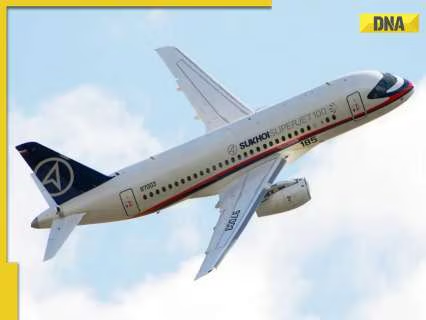
The press release called it “a new chapter in Indian aviation history” and a step toward Aatmanirbhar Bharat. Politicians smiled for cameras. Headlines celebrated Indian manufacturing prowess. There’s just one problem: we’re fooling ourselves.
On October 27, 2025, Hindustan Aeronautics Limited signed an agreement with Russia to manufacture the Sukhoi Superjet 100 in India. The press release called it “a new chapter in Indian aviation history” and a step toward Aatmanirbhar Bharat. Politicians smiled for cameras. Headlines celebrated Indian manufacturing prowess. There’s just one problem: we’re fooling ourselves.
Let’s be brutally honest. India isn’t manufacturing an aircraft. We’re assembling a Russian plane using Russian engines, Russian avionics, Russian design—essentially operating as a glorified screwdriver shop while calling it self-reliance. The last time India produced a complete passenger aircraft was the AVRO HS-748, which we started building in 1961 and stopped in 1988. That’s 37 years ago. We haven’t progressed; we’ve regressed. Now we’re celebrating the “achievement” of bolting together someone else’s creation.
The Sukhoi Superjet 100 itself tells you everything about why this deal happened. It’s a twin-engine, narrow-body regional jet designed to carry 87-108 passengers on short routes of 2,000-4,500 kilometers—perfect for India’s UDAN scheme connecting tier-2 and tier-3 cities. More than 200 have been built, and about 16 airlines operate them worldwide. Sounds impressive until you examine the fine print.
The SJ-100 has been a commercial disaster. Airlines hate it. Mexico’s Interjet grounded its entire fleet. Irish carrier CityJet dumped theirs after endless maintenance nightmares. Russian airlines themselves—the captive home market—complain constantly about reliability. The aircraft’s dispatch reliability hovers around 85%, meaning one in six scheduled flights faces delays or cancellations due to technical issues. For comparison, Boeing and Airbus achieve 99%+ dispatch reliability. The SJ-100 uses engines from PowerJet—a joint venture between Russian and French companies—but after Western sanctions over Ukraine, the French partner exited. Russia scrambled to replace French components with domestic alternatives, creating a Frankenstein hybrid that even Russian airlines view skeptically.
And this is what India plans to build domestically to serve 550 aircraft worth of demand over the next decade.
Here’s what the press release won’t tell you: the SJ-100’s engines, the SaM146, produce roughly 14,000 pounds of thrust each. They’re decent engines but represent 40-year-old Western design philosophy with Russian manufacturing quality—which means higher fuel consumption, more frequent maintenance, and shorter operational life compared to modern Western engines on competing aircraft like the Embraer E-Jets or Airbus A220. The cockpit uses Russian avionics and flight management systems that pilots trained on Western standards find archaic. The composite materials in the wings and fuselage? Imported. The landing gear? Licensed French technology. The auxiliary power unit that starts the engines and powers systems on the ground? Foreign.
Strip away the “Made in India” sticker, and you’re left with an aircraft that India contributes perhaps 15-20% of value addition to—mostly labor-intensive assembly work and some structural components. We’re not developing engineering capabilities; we’re providing cheap labor for a troubled Russian program that Western airlines won’t touch.
But here’s the deeper tragedy: we’ve been down this road before, and we learned nothing.
The AVRO HS-748 program that ended in 1988 should have been India’s springboard into modern aviation manufacturing. We built 89 aircraft over 27 years. We should have used that experience to design our own regional aircraft in the 1990s when the market was exploding. Instead, we let the expertise atrophy, the supply chains dissolve, and the institutional knowledge walk out the door. Thirty-seven years later, we’re back to square one—assembling foreign designs.
Meanwhile, look at what China did. In the same period India was doing nothing, China launched the ARJ21 regional jet program in 2002 and the C919 narrow-body program in 2008. Both aircraft faced delays, technical problems, and Western skepticism. But China persisted. The ARJ21 now has over 120 aircraft in service. The C919 just entered commercial operations with Chinese airlines and has 1,200+ orders. Are they as good as Boeing or Airbus? Not yet. Do they rely heavily on Western components? Absolutely—the C919 uses American engines, French landing gear, and German avionics. But China is systematically developing domestic alternatives. They’re learning. They’re building aerospace engineering talent. They’re creating an ecosystem.
India is doing… what, exactly? Assembling Russian regional jets that Russian airlines don’t want?
The SJ-100 deal exposes India’s fundamental confusion about industrial policy. Real self-reliance doesn’t mean slapping “Made in India” labels on imported kits. It means developing core competencies over decades through sustained investment, even when results disappoint. It means building the metallurgy expertise to forge turbine blades, the computational capabilities to design airframes, the testing infrastructure to certify aircraft—all the unglamorous, capital-intensive, technically difficult work that countries like the US, France, and China invested in for 50+ years.
Instead, India takes shortcuts. We announced the Regional Transport Aircraft program in 2009 to design a 70-90 seat turboprop. Sixteen years later, there’s no aircraft. We started the Saras light transport aircraft in 1991. Thirty-four years and numerous crashes later, it’s still not certified for civilian operations. We began the Kaveri jet engine program in 1989. Thirty-six years and $2 billion later, we still import every fighter jet engine. This isn’t bad luck—it’s a systematic failure to commit to long-term aerospace development.
The tragic irony? India has brilliant aerospace engineers—they’re just working for Boeing, Airbus, Rolls-Royce, and NASA because India offers neither the infrastructure nor the ambition to utilize their talents. We export brains and import aircraft, then wonder why we’re not self-reliant.
The government estimates India needs 200 regional jets for domestic connectivity plus 350 for the Indian Ocean region over the next decade. That’s a $25-30 billion market opportunity. We could have spent the last 20 years developing an indigenous aircraft to capture even 30-40% of that market. Instead, we’ll assemble Russian jets while the profits, the technology, and the strategic control remain in Moscow.
This isn’t Aatmanirbhar Bharat. This is Aatma-dhoka Bharat—self-deception masquerading as self-reliance. Until India commits to the hard, expensive, decade-spanning work of building genuine aerospace capabilities, we’ll keep celebrating “new chapters” that are really just reprints of old failures. The SJ-100 deal isn’t a beginning—it’s evidence that we still haven’t learned how to begin.
(The author of this article is a Defence, Aerospace & Political Analyst based in Bengaluru. He is also Director of ADD Engineering Components, India, Pvt. Ltd, a subsidiary of ADD Engineering GmbH, Germany. You can reach him at: girishlinganna@gmail.com)
(Disclaimer: The views expressed above are the author’s own and do not reflect those of DNA)





